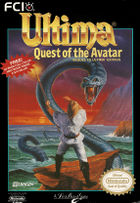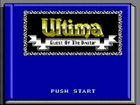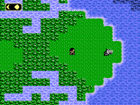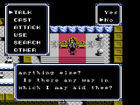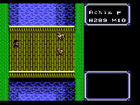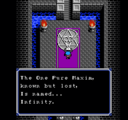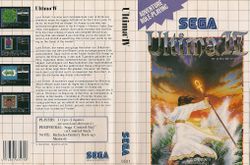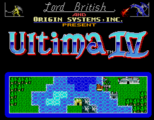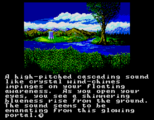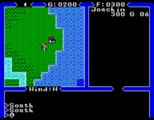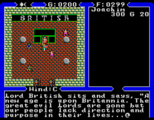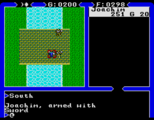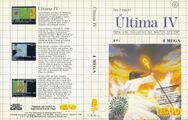Console ports of Ultima IV
Ultima IV comes in two console versions. Nintendo was not happy that Origin had developed a port for Sega as well, and the threat of going to the courts delayed the Sega-port. However, the threats proved empty, and development proceeded.
The two ports are very different, and both games were released in North America in 1990 (although the NES/Famicom remake was released in Japan in 1989, one year before the Japanese release of the Sega-port).
The Nintendo Version[edit]
The Nintendo (NES)-port of Ultima IV has a similar look and play-style to port of Ultima III, and incorporates many elements of classical Japanese console role-playing games like Final Fantasy into its gameplay. The interface had been streamlined considerably from the computer versions of the game and has obviously been adapted to fit the limitations of the system's four button controller. Like the Ultima III Nintendo game, the musical score for this version has been completely replaced, with a new soundtrack having been composed by Seiji Toda for this release. Nintendo Power featured Ultima IV as an 8-page review in February 1991, giving the game a rating of 3.3/5 for graphics and sound, 3.4 for play controls, 3.5 for challenge, and 3.7 for play and fun.[1]
More than its predecessor, this NES-ported game differs in numerous ways from the game which originally inspired it, to the point that it can be considered a remake.
When this game was originally developed in Japan for the Famicom, 46 characters were removed (although some identical guards were given unique individual dialogue). When the Japanese version was localized in English, another 41 characters were inexplicably removed (full list here), bringing the talking population of Britannia from 256 down to 169: a 40% reduction!
A great deal of the gameplay appears somewhat abbreviated in comparison to computer releases, with towns and dungeons rendered smaller and more compact and character dialog trees having been replaced with single statement barks. Mechanics such as starvation and wind changes are also absent from gameplay, making at times for a less complex experience. Spellcasting has also been simplified, with reagent mixing no longer being required to cast spells. The party size has also been reduced to four, although all eight companions may still be recruited, and may be changed in and out of the party at Castle Britannia.
The introduction and endgame have also been greatly pared down, with the former having been largely transferred to a narrative in the manual. The famous test as to the composition of the Eight Virtues, that originally was part of the endgame, was split up into seven questions asked at the Virtue Stones altars in the seven dungeons. On the other hand, the ending now includes the celebration which Terri will discuss in Ultima VI.
The Stranger's magic point maximum raises to 99 when attaining Eight-Parts Avatarhood. This creates a point of continuity with Ultima V, where the same character starts the adventure with a high amount of magic points, regardless of the class.
The combat system reflects other console role-playing games of the age, with random encounters occurring without warning on the world surface. While combat remains tile-based, character actions are determined collectively at the beginning of a turn instead of being executed individually. Monster artificial intelligence also appears to be more primitive, with enemies failing to flee when injured and often walking into damage fields they themselves created. Unlike the computer releases, flight from battle is always an option, even at sea. Dual weapon slots have also been added, allowing characters to equip both ranged weapons and close-combat weapons simultaneously (possibly because the option to change weapons during combat was removed). Missile weapons can be shot diagonally at any enemy in the battlefield, even across obstacles.
Most noticeable among the changes between versions, however, is likely the ambiguity of character's genders, as all recruitable characters are referred to by male pronouns. As the sprites for character classes are identical, this also leaves the apparent gender of the protagonist to be determined by character class and rather awkwardly renders the companion Julia as a man named Julius, that he might fit with the bearded masculine sprite used for tinkers.
Included with the Game[edit]
- NES Ultima IV Manual
- Map (international release only)
Gallery[edit]
NES Lord British
The NES remake restores the Pure Axiom that Smith forgot to reveal.
The Sega Version[edit]
The version for the Sega Master System (SMS) is very different, since unlike the Nintendo-port, it stays more faithful to the original. The port was handled by Sega of America, but ended up not being released in the United States.[1] The game was released in Canada, Europe, and Brazil only, with limited North American distribution through imports. The very similar feel to the original version already starts with the game box, which not only uses the original box art, but also includes a paper map of Britannia similar to the original cloth map. The History of Britannia and The Book of Mystic Wisdom, are included, only reduced slightly in size, and a detailed manual is also included. This is opposed to the NES-port, which only has an instruction booklet.
The game itself is very much like the 16-bit versions on the computers, only with improved western-style graphics. The music is the same as the original, but improved in quality. The game also includes the complete introduction.
There are essentially three major changes in the game:
- The first is the dialogue system. The player can only initiate dialogue on material the Stranger has learned (similar to Ultima VII). This prevents players from taking shortcuts during the quests.
- The second concerns the dungeons. While the SMS could handle them in first-person view, all the dungeons are seen from the top with each square now being a 2x2 block[2], which makes navigating in them easier, as they resemble dungeons from Ultima VI. In spite of this different point of view the dungeon maps remain mostly the same as their computer counterparts. However now energy fields take up four squares and the number of chests are doubled.[3]
- The third aspect is the combat system. Unlike the original version, which only allowed to attack vertically and horizontally (just like in Ultima III), this port uses a combat system closer to Ultima V allowing the characters to attack diagonally as well. This way, battles end much faster.
There were French, German, and English versions of the game released. The in-game text was always in English, with only the print materials being translated, though.
Included with the Game[edit]
- The History of Britannia
- The Book of Mystic Wisdom
- Instruction booklet
- Map
Conversion Error[edit]
- In the original and in computer ports of Ultima IV, the Ankh of Spirituality in Skara Brae reveals critical information about locating the Shrine of Spirituality. In the Master System port, that text is inaccessible, leaving the Avatar to guess how it can be accessed.
Gallery[edit]
See Also[edit]
External Links[edit]
- Ultima IV: Quest of The Avatar – NES Gameplay
- Ultima IV intro and class selection – Sega Master System
- Scans – Ultima IV: Quest of The Avatar – manuals and map of the Sega Master System version
References[edit]
- ↑ "Ultima: Quest of the Avatar". Nintendo Power (Ultima IV). Feb. 1991. Pages 70-77, 85.
- ↑ Pix. “Ultima 4 (Sega Master System) – Part 3”. Pix's Origin Adventures. 2013-06-01. Retrieved 2013-06-18.
- ↑ Pix. “Ultima 4 (Sega Master System) – Part 4”. Pix's Origin Adventures. 2013-06-05. Retrieved 2013-06-18.
| Console Ports | |
|---|---|
| Games | Ultima III ☥ Ultima IV ☥ Ultima V ☥ Ultima VI ☥ Savage Empire ☥ Ultima Underworld ☥ Ultima VII |
